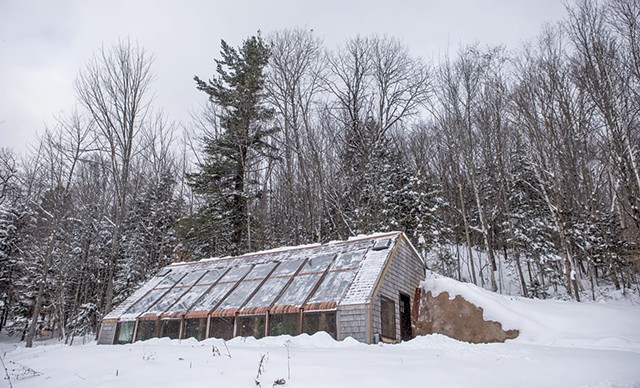
- Luke Awtry
- Brenden McBrier's earthern greenhouse in Johnson
Barely visible between evergreens and sleeping hardwood trees, the snow-covered home in Johnson fit the postcard-perfect image of Vermont winter. But a closer look at the slanted glass wall revealed something unusual inside: a lush oasis of fig trees, kiwi vines and the broad, green leaves of tomato plants.
As it turns out, the structure is actually a year-round greenhouse. And unlike most cold-weather greenhouses, which are built from new materials, this one is largely made of earth and old tires. Its warmth comes from the sun and the 10-foot, man-made hillside behind it.
The greenhouse was designed in 2022 for an intentional living community, Awakening Mountain, by one of its residents, Brenden McBrier, 33. The owner of Regenerative Retrofits, a design and build company, he specializes in sustainable architecture and small-scale food production, also known as permaculture. He based his greenhouse concept, which he plans to replicate across the country, on the Earthship style of architecture, which uses natural and upcycled materials to collect and store Earth resources like energy from the sun and rainwater and grow food on-site.
Earthships facilitate comprehensive off-grid living, providing for everything from cooking and sleeping space to water catchment and sewage treatment. McBrier's "earthern greenhouse," as he calls it, is focused on the food production aspect. In mid-December, he opened the door to the Johnson greenhouse and gave Nest a tour.
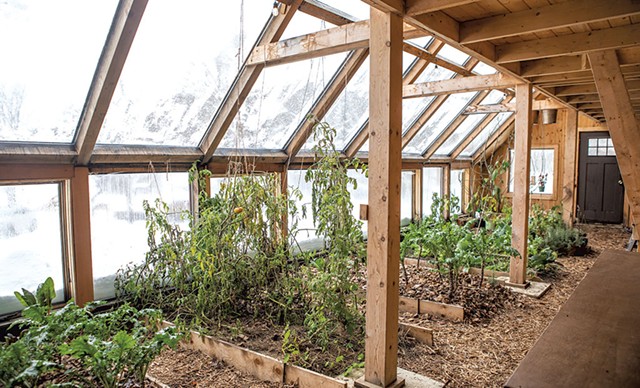
- Luke Awtry
- Inside of Brenden McBrier's earthern greenhouse in Johnson
Outside, the weather was in the low 30s. Snow covered the massive mound of "rock" — made of sand-based cement, earth and old tires — that serves as the greenhouse's back wall and helps moderate its temperature. Each tire is packed with earth, stacked, and mortared with cement or a cement alternative. The earth acts like a battery to store thermal energy at a relatively consistent temperature, helping occupants stay cool in the summer and warm in the winter. One step inside the structure revealed humid, much warmer air.
Reddish-gold light from the sun ricocheted off the hemlock beams. Food crops flourished in six neat raised beds set against the glass wall. McBrier, sporting long dreads and a relaxed demeanor, pointed out mint, nasturtiums, a lime tree, kale, broccolini and massive cabbages.
"We're getting our last little push here," he said, pointing to the heavy green tomatoes drooping from a line of plants taller than he was. The harvest of those fruits was happening at least two months later than it typically would outdoors.
In a far corner, McBrier gestured to two hardy fig trees that he said had produced 50 figs that year. In another corner, a woodstove crackled. His two banana plants died the previous winter, when the greenhouse temperature dipped to 31 degrees. That was still about 50 degrees warmer than outside, he said, but the woodstove now adds a little more heat.
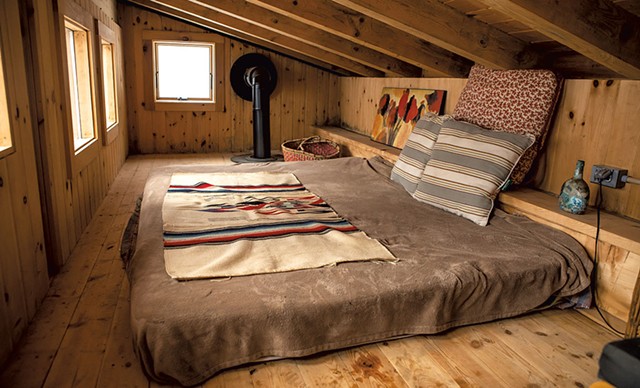
- Luke Awtry
- The loft
While the owner of Awakening Mountain didn't opt for solar panels on this structure, McBrier cited solar as a way to supplement thermal heat production in a greenhouse without using fossil fuels.
Against the wall opposite the windows, two long potting tables lay atop four black drums apiece. Each contained water that absorbed heat from the sun to further moderate the indoor temperature.
Between the drums, a small ladder leads to a loft space where guests can sleep or relax. The loft also houses fans that suck heat from above and send it underground through thermal cooling tubes under the garden beds during the summer months.
The lower portion of the greenhouse is about 720 square feet; the loft brings the total square footage to 1,000. The loft's low ceiling forced McBrier to hunch while sitting in a chair, but the vantage offered a great view of the foliage below, as well as the valley beyond. The loft design could be expanded for future clients looking for more headspace, he said.

- Luke Awtry
- Brenden McBrier in the loft
Originally from Colorado, where he was a landscaper, McBrier moved to Vermont seven years ago. His experience working at apple orchards and sugaring operations — and seeing how important they are as local gathering places — convinced him to stay.
"There was that connection with the Earth that I was really seeking in Colorado that I just didn't have, other than through landscaping," he said.
McBrier built a tiny home in Johnson and eventually worked for fellow resident Michael Zebrowski, founder of Up End This, a sustainable design company and tiny house manufacturer. McBrier helped build the company's low-barrier shelter pods on Burlington's Elmwood Avenue in 2022.
"He's a hard worker, and he really helped that project over the finish line," Zebrowski said.
McBrier has studied Earthships extensively, beginning with a 2016 project in Uruguay through the Earthship Biotecture Academy. Since then, he's helped build Earthships, tiny houses and other sustainable homes across the United States and beyond.
Earthships aren't new; architect Michael Reynolds introduced the concept in the 1970s, and there are at least a handful in the Green Mountain State. But McBrier may be the first Vermonter to apply the principle to greenhouses. In a state with so many gardeners and nature lovers, it's easy to see how the upcycled, climate-friendlier design could take off.
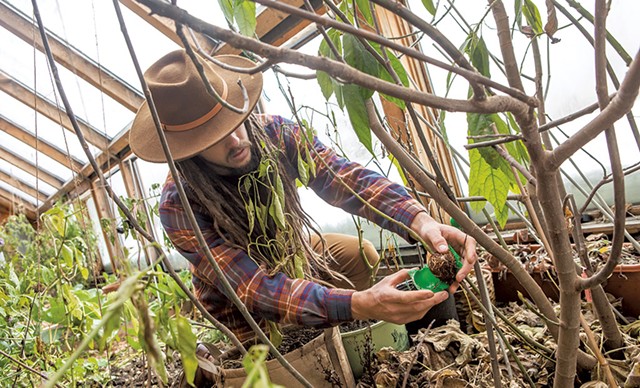
- Luke Awtry
- Brenden McBrier tending to his plants
"So much of the greenhouse industry does rely on a huge amount of energy to create that climate," said Cymone Bedford of Morrisville, who lived in a Vermont Earthship for more than two years.
"What Earthship design does is make [structures] super-efficient and optimizes things so you don't need as much energy input," she added. "It allows you to grow things you [otherwise] wouldn't be able to grow there, especially at different times of the year."
The protection that earthern greenhouses provide to plants extends beyond temperature. They also guard against wind damage from storms and could incorporate water-catchment systems in flood-prone areas — a prevalent concern in Vermont as climate change takes hold.
"When our town gets slammed by a flood twice in five months, you can't say it's a hundred-year event," said Zebrowski, whose manufacturing production space was inundated with 42 inches of water last summer. In the face of so many environmentally damaging conditions, he said, more people are looking for climate-friendly solutions.
McBrier insists those solutions needn't be expensive. Earthships can be built quickly by a large group of people, using as many found materials as possible. His recommendation for those who aren't sure they're ready to commit? Start small.
"Start with a pot," he said. "Build a small greenhouse off a shed."
It's sage advice, since Earthships are all about adaptation.

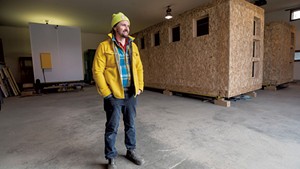
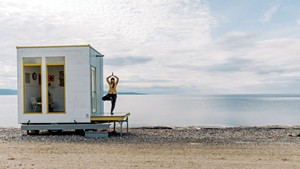









Comments
Comments are closed.
From 2014-2020, Seven Days allowed readers to comment on all stories posted on our website. While we've appreciated the suggestions and insights, right now Seven Days is prioritizing our core mission — producing high-quality, responsible local journalism — over moderating online debates between readers.
To criticize, correct or praise our reporting, please send us a letter to the editor or send us a tip. We’ll check it out and report the results.
Online comments may return when we have better tech tools for managing them. Thanks for reading.